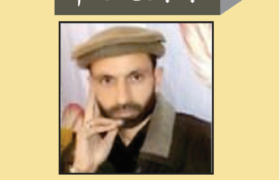If any Pakistani daily had entertained Sirajuddin Haqqani’s article, it would have been enough to establish links between Islamic insurgents and Islamabad or to label Pakistan as terrorists’ backer. In that case besides barrage of criticism from Afghanistan and India, it would also had provided an opportunity to Pakistani so-called liberals, democrats and non-governmental organizations to accuse Islamabad for supporting good Taliban (the term often used by them) and requesting Trump administration for stopping financial aid to Pakistan or to blacklist the country via FATF.
It is harsh reality that Pakistanis have very short memory besides they don’t bother to do any research or counter check any issue; and in current social media environment, countries and elements exploit this to further their agenda. Lack of knowledge and research make our youngsters prone to these social media propaganda and thinking negatively about their own country and state institutions. In this backdrop, government have introduced its new social media policy and are mulling to impose credible restrictions on social media in Pakistan.
Coming back to the issue of Haqqani article, it leads us to few very important questions, such as, why did Sirajuddin Haqqani publish an article in New York Times and what was the purpose of that article? Interestingly why did The New York Times allowed it that draw a strong criticism from Afghanistan?
Who is Sirajuddin Haqqani, a notorious terrorist and the deputy head of Afghan Taliban? Is Haqqani network really a terrorist outfit? When the US and its allies did start fighting the Haqqani network? To find answers to these questions we need to go some four decades back to the history.
In 1979, when the former Soviet Union (USSR) invaded and captured Afghanistan on 25th December; this adventurism shook the anti Communism world lead by US, to stop the spread of Communism, US and its allies started an open war against Russia in Afghanistan. They lured Muslims from all over the world either by the emotional slogan of jihad or by dollars. They invested billions in establishing seminaries (Madrassas) across Pakistan, of which several hundreds were built in Khyber Pakhtunkhwa and former FATA, the aim was to produce foot soldiers for the Afghan Jehad.
Anti-communism Afghan religious and political leaders were shifted to Peshawar to train people for a guerrilla war and launch jihad in Afghanistan again for this war billions of dollars in cash and ammunition were provided to the Afghan leaders here in Pakistan.
It was the time when several jihadi leaders like Younis Khalis, Gulbadin Hikmatyar, Burhan Uddin Rabbani, Sibghatullah Majaddidi, Pir Gillani, Ustad Abdurrab Rasool Sayaf and Ahmad Shah Massoud who came and settled in Peshawar were already familiar to the International press, However, there was a guerrilla commander in southern Afghanistan who took the Russian troops by a surprise and offered a deadly resistance to them was no other tha Jalal Uddin Haqqani, His men mostly from the Zadran tribe in Khost & Paktia provinces showed strong resistance inflicted heavy losses on Russian and Afghan forces. In 1987, Commander Jalaluddin Haqqani’s fighters captured and blocked the main Kabul-Paktia road at Sato Kandao point From November 9, 1987 to January 1988,the long fight resulted in heavy casualties leaving around 300 Afghan and Russians troops dead while more than 1000 soldiers were wounded.
Jalaul Uddin Haqqani the founder of so-called Haqqani Network was such a blue eyed Mujahideen Commander of the anti-communist world that former US president Ronald Reagan called him “Freedom Fighter”. Similarly the renowned US lawmaker turned war manager in Afghanistan, Charlie Wilson referred to the elder Haqqani as “goodness personified”. Such was the level of trust between US and Haqqani that he was was the only other jihadist leader who was provided by US with stinger missiles.
Following Geneva Accord 1988 when the Russian troops announced exit and withdrew from Afghanistan, the US and its allies welcomed Jalaluddin Haqqani as a hero.
US and its Western allies abandoned Afghanistan soon after the USSR withdrawal, hence fighting started between the various factions of Afghan Mujahideen for a government, this internal fighting caused more devastation to the country than it was done by the Russians. Afghans were tired of the continuous fighting so they supported a small uprising by a local madrassa leader in Kandahar province who later became Taliban movement, the Taliban movement took over 95% of the country by mid-1990s, Jalaluddin Haqqani also became part of it.
However, after 11/9 tragic incident US and its allies topped Taliban regime. The US tried to win the support of Jalaluddin Haqqani who was offered different positions in Afghan government but he did not accept them. The US declared him as terrorist and his group was named as “Haqqani Network” a network labelled as terrorist outfit, Pakistan was blamed for secretly supporting Haqqani network to resist against foreign forces and to destabilize Afghan government. Following Jalaluddin Haqqani’s death in 2018, his son Sirajuddin was named as his successor.
Sirajuddin Haqqani who authored the recent article for The New York Times, is the son of the same jihadist Jalaluddin Haqqani. He is the deputy head of Afghan Taliban and one of the strongest Taliban commander in Afghanistan.
President Obama went all out with Afghan war in his two terms as a president but the new US President Donald Trump, announced change in Afghan policy and withdrawal from the region, this new US Afghan policy helped paving ways for peaceful settlement with the fighting Taliban in Afghanistan. Trump administration to the very extent sought Pakistan’s help to use its influence over Taliban to bring them to negotiation table. Due to continuous efforts from Pakistan, Taliban agreed for talks and are now inching towards signing peace agreement at the end of this month.
Now, when the US is all set to sign a peace deal with Afghan Taliban, it would also establish that Taliban are no more terrorists, the cases against them to be withdrawn and their thousands of prisoners would be released from Afghan jails.
Actually in international relations there are no permanent enemies, and no permanent friends, the only “permanent” in international relations is interest.
Following peace agreement, Taliban would end violence and come into power under a formula, US troops would leave Afghanistan and go back home thousands miles away, but unlike US or NATO Pakistan has no where to go, as a neighbor it has to be here permanently sharing borders with Afghanistan. Afghanistan good or worse internal situation directly affects Pakistan, just like previously when USSR invaded Afghanistan in 1979, more than five million Afghan refugees crossed border over to Pakistan, and after four decades still over two million Afghan refugees are living in Pakistan. Peace and stability inside Afghanistan is in the best interests of Pakistan, because it cannot afford another influx of refugees in case of any other Afghan conflict that is the reason Pakistan is trying it sincere efforts to play its role in Afghan peace process.
If in past Pakistan hosted Afghan guerrilla leaders and jehadis it was just to protect its borders against the then USSR and nothing else.
Interestingly the Mujahideen leaders who took shelter in Pakistan during Russian occupation are now key stakeholders in Afghan Government, Afghan government officially commemorate the day of USSR withdrawal, and acknowledge the war against USSR occupation as a Jehad or freedom war, but ironically Pakistan’s valuable sacrifices in that war (Jehad) are neither acknowledged by Afghans nor by the West and blame Pakistan for interfering into Afghanistan’s internal matters, this policy of the hypocrisy towards Pakistan should be replaced with appreciation.



